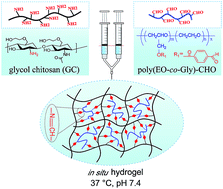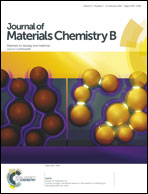An injectable hydrogel formed by in situ cross-linking of glycol chitosan and multi-benzaldehyde functionalized PEG analogues for cartilage tissue engineering†
Abstract
In this study, a multi-benzaldehyde functionalized poly(ethylene glycol) analogue, poly(ethylene oxide-co-glycidol)-CHO (poly(EO-co-Gly)-CHO), was designed and synthesized for the first time, and was applied as a cross-linker to develop an injectable hydrogel system. Simply mixing two aqueous precursor solutions of glycol chitosan (GC) and poly(EO-co-Gly)-CHO led to the formation of chemically cross-linked hydrogels under physiological conditions in situ. The cross-linking was attributed to a Schiff's base reaction between amino groups of GC and aldehyde groups of poly(EO-co-Gly)-CHO. The gelation time, water uptake, mechanical properties and network morphology of the GC/poly(EO-co-Gly) hydrogels were well modulated by varying the concentration of poly(EO-co-Gly)-CHO. Degradation of the in situ formed hydrogels was confirmed both in vitro and in vivo. The integrity of the GC/poly(EO-co-Gly) hydrogels was subcutaneously maintained for up to 12 weeks in ICR mice. The feasibility of encapsulating chondrocytes in the GC/poly(EO-co-Gly) hydrogels was assessed. Live/Dead staining assay demonstrated that the chondrocytes were highly viable in the hydrogels, and no dedifferentiation of chondrocytes was observed after 2 weeks of in vitro culture. Cell counting kit-8 assay gave evidence of the remarkably sustained proliferation of the encapsulated chondrocytes. Maintenance of the chondrocyte phenotype was also confirmed with an examination of characteristic gene expression. These features suggest that GC/poly(EO-co-Gly) hydrogels hold potential as an artificial extracellular matrix for cartilage tissue engineering.


 Please wait while we load your content...
Please wait while we load your content...